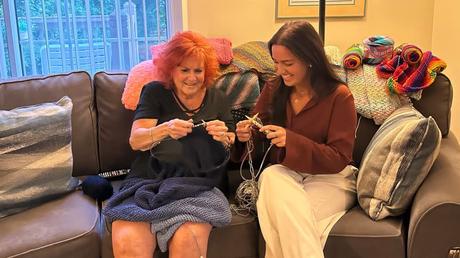When I walk into my grandmother's house, I see her hands weaving rapidly as stitches emerge from her knitting needles. Next to her are piles of knitted blankets, shawls and ponchos, stitched in carefully selected color schemes and patterns from wool yarn. She donates these blankets to children's hospitals and foster homes.
Her favorite pastime is creating. She is always crafting, whether it is knitting, coloring, scratch art or, more recently, experimenting with gemstone art. These activities give her satisfaction and purpose in ways that are more fulfilling than work.
She passed her love of arts and crafts on to the rest of my family. My mom joined theater groups when she was an empty nester and learned to paint. My younger cousin is a nature photographer and his dad (my uncle) has a comedy podcast with voice actors. My twin brother and I sang in college - it kept us sane while balancing our heavy academic workloads.
We thought it was good for our health, and we were right. Making art lowers levels of cortisol, the body's stress hormone, according to previous research.

"Engaging in arts and crafts is accessible and affordable. Options such as knitting and drawing require very few tools and can be engaging and creatively satisfying activities," said Dr. Helen Keyes, a cognitive psychologist and head of the department of psychology and sports science at Anglia Ruskin University, via email.
A new study by Keyes and fellow researchers finds that participating in creative activities can significantly improve well-being by creating meaningful spaces for expression and performance.
While previous research has shown that making arts and crafts can be therapeutic for people with mental health conditions, research on the general population has been under-researched, according to research recently published in Frontiers in Public Health.
So they studied members of the general population without diagnosed diseases to see how arts and crafts can contribute to well-being and reduce loneliness in everyday life.
The team used data from a large national survey in the UK between 2019-2020 to investigate how creative activities might influence life satisfaction, taking into account variables known to influence wellbeing, such as gender, age group, health, employment status and deprivation. The researchers analysed a sample of 7,182 participants living in England (aged 16 and over) from the annual Taking Part survey conducted by the UK Department for Culture, Media and Sport, which investigated how the public engage with these activities.
"We limited our analysis to arts and crafts at a broad level, rather than focusing on specific hobbies, because we know that people's preferences differ and they will find the craft or creative activity that suits them best," Keyes said.
More than 37% of survey respondents confirmed that they had participated in at least one craft activity in the past year. They were also asked about their employment status, their health, their sense that life is worth living, how often they feel lonely, and their levels of perceived happiness, anxiety and life satisfaction.
Reported happiness, life satisfaction, and sense of life worth living were positively correlated with arts and crafts participation, but arts and crafts were not associated with reduced anxiety or loneliness, warranting further investigation. More research is needed to explore the social aspects of creative activities, the researchers said.
"All forms of art can be beneficial for mental health. Benefits include increasing self-confidence, reducing anxiety/stress, improving communication, and encouraging creativity," Dr. Frank Clark, a psychiatrist at Prisma Health and a poet, said via email. Clark was not involved in the study.
Art and craft for public health
The researchers suggested that arts and crafts could improve public health.
"Governments and national health services could consider funding and promoting crafts, or even socially prescribing these activities to at-risk groups as part of a wellness and mental health promotion and prevention approach," Keyes said. "Engaging in crafts is something that is relatively easy to introduce into your life."
Creativity has not one look
Crafting offers the opportunity to experience a sense of fulfillment and expression through creation.
"A sense of mastery is important for well-being, and there is an inherent sense of mastery associated with making and creating art; that is, people can see their progress and take pride in what they produce," Keyes said via email.
If you don't consider yourself artistic or creative, Clark has four suggestions for tapping into your creative side: shift your mindset and be optimistic about your creative potential; don't be afraid to take risks to try a new activity; build relationships with people who are in a creative phase that interests you; and think about what you did creatively as a child and do it again.
Try it yourself
One inexpensive way to get creative is coloring. While some may see coloring as a children's activity, "I love adult coloring books and encourage everyone to embrace their inner child," Clark said. "Coloring is an example of a mindfulness activity that has a multitude of health benefits. It can help foster social connections, improve concentration, and spark creativity."
And if you are creative, anything can happen. "Creativity has the power to foster resilience, recovery and reconciliation," he said. "It is a cathartic antidote that can help give humanity a sense of meaning and purpose."
For more CNN news and newsletters, create an account at CNN.com
